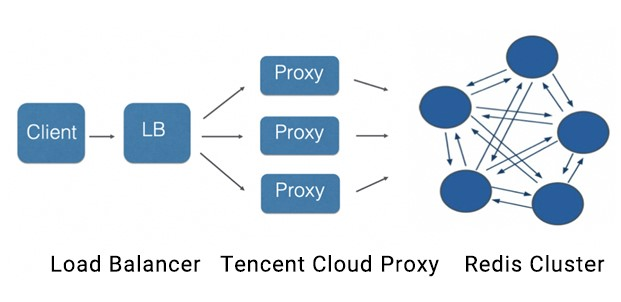标准架构迁移集群架构检查
最后更新时间:2024-11-05 10:00:29
标准版包括用户自建的单机、主从模式以及腾讯云数据库 Redis® 内存版(标准架构),本文为您介绍标准版 Redis 迁移至腾讯云数据库Redis 内存版(集群架构)的兼容性相关内容。
兼容性说明
兼容性说明
腾讯云数据库 Redis® 内存版(集群架构)采用自研 Proxy 加社区集群版的架构,100%兼容社区 Redis Cluster 的命令。

标准版迁移至内存版(集群架构)面临的最大问题为命令是否兼容内存版(集群架构)的使用规范,内存版(集群架构)使用规范主要注意事项如下:
多 Key 操作
社区 Redis Cluster:不支持任何跨 SLOT 的多 Key 访问命令。
腾讯云数据库 Redis® 内存版(集群架构):支持 MGET、MSET、DEL 命令的跨 SLOT 多 Key 访问,主要原理是通过腾讯云自研 Proxy 实现多个节点的命令聚合运算。
Hash Tag:业务可以通过 Hash Tag 的方式,将需要进行多 Key 运算的 Key 聚合至相同 SLOT,Hash Tag 的使用方式请参考 Redis Cluster 文档。
跨 SLOT 命令列表:
命令族 | 命令 | 内存版(集群架构)跨 Slot 支持 |
keys 族 | del | ✓ |
| exists | ✓ |
| rename | x |
| renamenx | x |
| unlink | x |
list 族 | rpoplpush | x |
| blpop | x |
| brpop | x |
| brpoplpush | x |
sets 族 | sdiff | x |
| sdiffstore | x |
| sinter | x |
| sinterstore | x |
| smove | x |
| sunion | x |
| sunionstore | x |
sorted sets 族 | zinterstore | x |
| zunionstore | x |
strings 族 | bitop | x |
| mget | ✓ |
| mset | ✓ |
| msetnx | x |
hyperloglog 族 | pfcount | x |
| pfmerge | x |
scripting 族 | eval | x |
| evalsha | x |
| script exists | x |
Stream 族 | xread | x |
| xreadgroup | x |
LUA 支持
内存版(集群架构)支持 LUA 命令,但 LUA 脚本中访问的 Key 不能跨 SLOT。
EVAL、EVALSHA 命令必须要传 Key 参数,否则命令将无法执行。
SCRIPT 的子命令 LOAD、FLUSH、KILL、EXIST 会通过 Proxy 分发至集群中所有的主节点。
> eval "return {KEYS[1],KEYS[2],ARGV[1],ARGV[2]}" 2 key1 key2 first second1) "key1"2) "key2"3) "first"4) "second"
说明:
LUA 使用时必须传参数 key1、key2。
事务支持
内存版(集群架构)支持事务,但是事务中的命令不能跨 SLOT 访问 Key。
当前线上版本需要先执行 watch key 命令,再执行 multi、exec,后续版本会进行优化,免除先执行 watch key 的动作。
自定义命令
自定义命令
Redis 内存版(集群架构)通过 VIP 封装,在集群模式下提供了标准版的使用体验,对业务的使用带来很大便利,但是对运维不够透明,因此通过自定义命令来弥补这些空缺,支持集群中每个节点的访问,支持方式为在原有命令的参数列表最右边新增一个参数“节点ID”,COMMAND arg1 arg2 ... [节点ID],节点 ID 可通过 cluster nodes 命令,或者在 控制台 中获取。
10.1.1.1:2000> cluster nodes25b21f1836026bd49c52b2d10e09fbf8c6aa1fdc 10.0.0.15:6379@11896 slave 36034e645951464098f40d339386e9d51a9d7e77 0 1531471918205 1 connectedda6041781b5d7fe21404811d430cdffea2bf84de 10.0.0.15:6379@11170 master - 0 1531471916000 2 connected 10923-1638336034e645951464098f40d339386e9d51a9d7e77 10.0.0.15:6379@11541 myself,master - 0 1531471915000 1 connected 0-546053f552fd8e43112ae68b10dada69d3af77c33649 10.0.0.15:6379@11681 slave da6041781b5d7fe21404811d430cdffea2bf84de 0 1531471917204 3 connected18090a0e57cf359f9f8c8c516aa62a811c0f0f0a 10.0.0.15:6379@11428 slave ef3cf5e20e1a7cf5f9cc259ed488c82c4aa17171 0 1531471917000 2 connectedef3cf5e20e1a7cf5f9cc259ed488c82c4aa17171 10.0.0.15:6379@11324 master - 0 1531471916204 0 connected 5461-10922原生命令:info server自定义命令:info server ef3cf5e20e1a7cf5f9cc259ed488c82c4aa17171SCAN命令示例:scan 0 238b45926a528c85f40ae89d6779c802eaa394a2scan 0 match a* 238b45926a528c85f40ae89d6779c802eaa394a2KEYS命令示例:keys a* 238b45926a528c85f40ae89d6779c802eaa394a2
客户端接入方式
建议用户使用标准版(例如 jedis,非 jedis cluster)的客户端访问云数据库 Redis® 内存版(集群架构),这种方式接入效率更高,使用简单,同时也支持 cluster 客户端的接入,例如使用 jedis cluster。
Codis 兼容性
腾讯云数据库 Redis® 内存版(集群架构)100%兼容 Codis-server 命令,业务无需更改,通过 DTS 服务即可快速迁移数据至云数据 Redis。相对于 Codis 有如下优势:
兼容版本更多,Codis 已停留在3.2版本,云数据库 Redis® 内存版(集群架构)现在已支持4.0、5.0版本,且后续将持续跟进社区版本更新。
兼容命令更多,Codis 不支持阻塞命令的执行,如 BLPOP、SUBSCRIBE 等命令。
Codis 的数据迁移遇到大 Key 情况,可能会导致服务不可用,而云数据库 Redis® 支持无损扩展,无惧大 Key。
兼容性检查
目前没有工具可以100%确认从标准迁移到集群是否存在兼容性问题,下文提供的2个工具可用来辅助评估兼容性,从标准迁移到集群时,建议在迁移之前做好静态评估、动态评估、业务验证3个方面的验证工作,保证迁移工作顺利进行。
静态评估
1. 下载 cluster_migrate_online_check.py 静态工具,通过该工具执行 info commandstats 命令,分析标准版是否执行过跨 SLOT 相关命令,来辅助判断是否可能存在兼容性问题。
Usage:./cluster_migrate_check.py host port password
说明:
host、port、password 输入标准版 Redis 的信息。2. 参考上文的 兼容性说明,业务侧逐一评估每一项是否可通过。
动态评估
下载 cluster_migrate_online_check 动态验证工具,通过该工具模拟客户端执行 psync 命令,从标准版实时同步增量数据至云数据库 Redis® 内存版(集群架构),通过实时同步,可以确认写入命令是否存在兼容性问题。该工具无法覆盖读命令是否兼容的测试。
动态验证步骤如下:
1. 在 控制台 开通云数据库 Redis® 内存版(集群架构)。
2. 通过工具从标准版实时同步数据至云数据库 Redis® 内存版(集群架构)。
3. 经过一段时间的验证(如6小时或者24小时),如果工具没有报错说明写入命令没有兼容性问题,如果有报错可根据报错信息得到不兼容的命令信息。
Usage:./cluster_migrate_online_check srcip:srcport srcpasswd dstip:dstport dstpasswd环境变量参数:export logout=1 //打印命令到控制台,默认关闭export pipeline = 2000 //pipeline 并发数量,默认1000
说明:
srcip:srcport:必填,输入标准版 Redis 的地址信息。dstip:dstport:可选,输入云数据库 Redis® 内存版(集群架构)的地址信息,不填目标信息时可将该工具当 monitor 使用。4. 参考上文的 兼容性说明,业务侧逐一评估每一项是否可通过。
业务验证
为确保顺利进行迁移,建议用户在测试环境进行业务测试验证,通过将测试环境的业务连接至云数据库 Redis® 内存版(集群架构),来确认每个功能无误后再进行迁移。
使用 DTS 进行在线迁移
自建实例迁移失败处理
client-output-buffer-limit 参数配置过小,建议该参数配置到512MB或1024MB,配置命令如下:
config set client-output-buffer-limit "slave 1073741824 1073741824 600"
EVAL 命令未传参数。
文档反馈

